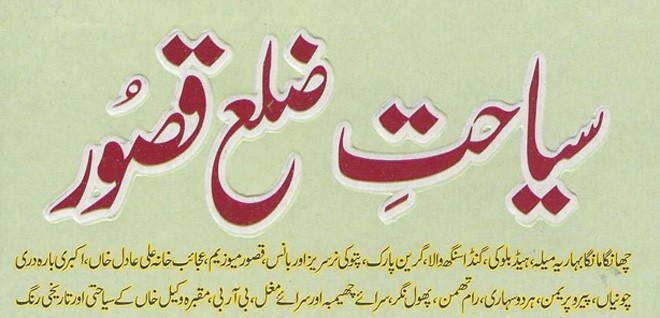
The book takes readers on a colourful journey through Kasur, inviting them to explore the city

Zafar Abbas Naqvi is quite a remarkable man -- there are scarcely any police inspectors in Pakistan avidly pursuing intellectual interests. And he happens to be one. It is evident that the man was a keen traveller and observer even as a young and impressionable student. His freewheeling may have been curtailed in a small way by his joining of the service in 1997 but that still did not curb his spirit of inquiry.
Over the years he thereby built up a large repertoire of travel tales and anecdotes. Add to this a sharp observation of what he sees on the way. From the mundane to the extraordinary natural or built object to stories related by locals Naqvi imbibes all with enthusiasm. Best of all he couples his folk knowledge with a reasonable dash of research.
Author of nearly 300 travel articles in various Urdu journals, Naqvi has now produced Siyahat-e-Zila Kasur (Travels and tourism in Kasur). Kasur is an understandable choice for the writer is a native of Chunian town of the district. Spread over 304 pages (the final twelve being maps) with thirty-two pages of colour pictures, this guidebook is a fine companion to anyone wishing to travel around Kasur district. Most of the sites described in the book are within, at most, a couple of hours’ drive from Lahore, which makes the book an essential for any Lahori wishing to break away from city hubbub for a weekend and go exploring.
Naqvi’s writing style is lyrical with the usual flamboyance we find in Urdu writing. We see it at its best as he describes Chhanga Manga forest and its many attractions. But we also see him turning elegiac as he focuses on the death of sericulture in this manmade forest. Until this book, one wondered what really had become of the dozens of private households and at least one government setup rearing silk worms until as late as the 1980s.
Naqvi informs us that the vast reserve of mulberry in the forest which fed the silk worms was destroyed unthinkingly by corrupt forest officials and sold to the sports goods manufacturers of Sialkot. With mulberry gone, sericulture slowly bled to death. Realising the huge loss in revenue, the government made a half-hearted and, unsurprisingly, foolish attempt at revitalising the industry -- they planted paper mulberry instead of the three or four different indigenous sub-species of the genus Morus.
Today, despite the passage of more than three decades since the killing of Chhanga Manga sericulture, we have no measures in place to bring back what once generated sizeable revenue.
The book touches upon the Ravi, Sutlej and Beas rivers that pass through the district and the various canals that take off from them. We thus get a short overview of the agricultural scene as well. And if you did not know it, Naqvi would rather call the nurseries of Pattoki ‘Pakistan’s Holland’ from the large variety of local and imported flowering and non-flowering plants. And you also learn that this district is also the only place in the country where bamboo is cultivated and seasoned for commercial use.
However, one thing that I was not aware of is the number of private resorts that have of late come up around Chhanga Manga and Balloki Headworks. Since both places are within ninety minutes drive on N-5 southbound from Lahore, these are the perfect places for Sunday brunches that can drag on into late lunches or high teas. And what better would a Lahori want than an orgy of eating!
For the lover of folklore, the book has a small sprinkling of tales regarding the name Chhanga Manga, Bhai Pheru and the love tale of Gulab Das and Pero Preman. The more serious reader will thrill to find the word on Ganda Singh, the general who took Multan for Maharaja Ranjit Singh. Naqvi has a small but rather disparaging passage on Bhagat Singh too. This latter hero of the freedom movement is buried just across the border from Ganda Singhwala.
What may be news to many is Kasur Museum. Until now the town was only famous for its fried fish and the mausoleum of the great Punjabi Sufi Bulleh Shah. It contains five galleries including prehistory, coins of various periods, Islamic period, Pakistan Movement and crafts of Kasur. As well as this, there is the important but little known family collection of Nawab Ali Adil Khan of a well-known Kasuri family.
Most important of all, the book contains notices on unknown Mughal caravanserais and of the priceless pleasure house of Todar Mal. And this is to name only a few. All these are now sadly in ruins, not because of natural causes but because of the malevolent hand of encroachers and treasure hunters. The book brings into focus the neglect so much of our built heritage faces at the hands of vandals.
All in all, this book is a useful item in the travel kit of anyone who wishes to learn something useful about Kasur. It should serve as a gentle nudge to Lahoris to get up and go before they lose their get up and go.